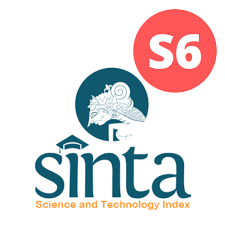Instrumen Penelitian Tindakan Kelas untuk Peningkatan Motorik Halus Anak
Abstract
The purpose of this study is to describe the design of research instruments in Classroom Action Research (CAR). The research method used is a qualitative method with data collection techniques using group discussions or Focus Group Discussion (FGD). The results of this study were conducted to determine whether the research instrument for improving children's fine motor skills with some improvements that have been made by researchers is in accordance with the direction of validators who are experts in the field of material to determine whether they are suitable for use by students or not.So with the improvements to the product design made, research instruments for improving children's fine motor skills were obtained which were declared valid by experts and deserved to be tested on children.
Tujuan penelitian ini yaitu mendeskripsikan rancangan instrumen penelitian pada Penelitian Tindakan Kelas (PTK). Metode penelitian yang digunakan adalah metode kualitatif dengan Teknik pengumpulan data menggunakan diskusi kelompok atau Focus Group Discussion (FGD). Hasil penelitian ini dilakukan agar mengetahui apakah instrumen penelitian untuk peningkatan motoric halus anak dengan beberapa perbaikan yang telah dilakukan oleh peneliti sesuai dengan arahan validator yang ahli di bidang materi menentukan layak digunakan untuk siswa atau tidak. Maka dengan adanya perbaikan terhadap rancangan produk yang dilakukan dihasilkanlah instrumen penelitian peningkatan motorik halus anak yang dinyatakan valid oleh para ahli dan layak di uji coba kepada anak.
The purpose of this study is to describe the design of research instruments in Classroom Action Research (CAR). The research method used is a qualitative method with data collection techniques using group discussions or Focus Group Discussion (FGD). The results of this study were conducted to determine whether the research instrument for improving children's fine motor skills with some improvements that have been made by researchers is in accordance with the direction of validators who are experts in the field of material to determine whether they are suitable for use by students or not.So with the improvements to the product design made, research instruments for improving children's fine motor skills were obtained which were declared valid by experts and deserved to be tested on children.Keywords
Full Text:
PDFReferences
Arifin, M., & Asfani, K. (2014). Instrumen penelitian. Applied Microbiology And Biotechnology, 85(1), 2071-2079.
Arifin, Z. (2017). Kriteria instrumen dalam suatu penelitian. Jurnal Theorems (the original research of mathematics), 2(1), 28-36.
Bisjoe, A. R. H. (2018). Menjaring Data dan Informasi Penelitian Melalui FGD (Focus Group Discussion): Belajar dari Praktik Lapang. Buletin Eboni, 15(1), 17-27.
Khoirunnisa, M. F., & Vinayastri, A. (2021). Pengembangan Instrumen Kemampuan Motorik Halus. Jurnal Golden Age, 5(2), 356-364.
Muarifah, A., & Nurkhasanah, N. (2019). Identifikasi Keterampilan Motorik Halus Anak. Journal of Early Childhood Care and Education, 2(1), 14. Nasution, H. F. (2016). Instrumen penelitian dan urgensinya dalam penelitian kuantitatif. Al-Masharif: Jurnal Ilmu Ekonomi Dan Keislaman, 4(1), 59-75.
Omar, D. (2018). Focus group discussion in built environment qualitative research practice. In IOP Conference Series: Earth and Environmental Science, 117(1), 1-8.
Sappaile, B. I. (2007). Konsep instrumen penelitian pendidikan. Jurnal Pendidikan dan kebudayaan, 13(66), 379-391.
Wandi, Z. N., & Mayar, F. (2019). Analisis Kemampuan Motorik Halus dan Kreativitas pada Anak Usia Dini melalui Kegiatan Kolase. Jurnal Obsesi: Jurnal Pendidikan Anak Usia Dini, 4(1), 351-358.
Wirdalena, S. Y., & Mayar, F. (2022). Pengembangan Bahan Ajar untuk Meningkatkan Kemampuan Motorik Halus Anak Berbasis Pendekatan Tematik. Jurnal Obsesi: Jurnal Pendidikan Anak Usia Dini, 6(6), 7242-7252.
Yusup, F. (2018). Uji validitas dan reliabilitas instrumen penelitian kuantitatif. Tarbiyah: Jurnal Ilmiah Kependidikan, 7(1), 17-23.
DOI: https://doi.org/10.17509/jpa.v6i1.51341
Refbacks
- There are currently no refbacks.
Copyright (c) 2022 JURNAL PAUD AGAPEDIA

This work is licensed under a Creative Commons Attribution-ShareAlike 4.0 International License.

This Journal is licensed under a Creative Commons Attribution-ShareAlike 4.0 International License.
©Jurnal PAUD Agapedia. ISSN: 2580-9679 (Online) dan 2581-2823 (Print).
Jalan Dadaha Nomor 18 Kota Tasikmalaya
Telepon (0265) 331860
Homepage: http://pgpaud-tasikmalaya.upi.edu/
Email: pgpaud_tasik@upi.edu






